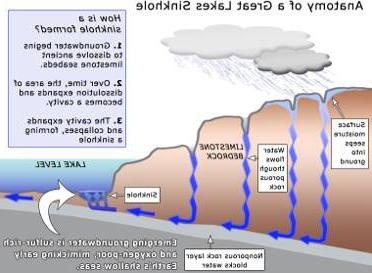Eos的微生物垫故事
2024年1月12日

Dr. Bopi Biddanda
The microbial ecology and biogeochemistry laboratory is focused on understanding the role microorganisms play in mediating ecosystem processes in the Great Lakes. Of particular interest is the influence of seasonal and climatic changes, 土地使用, and geology on the microbial community and physiology in watersheds, 淹没河口, 河口, and nearshore zones of the Great Lakes. 除了, we are also interested in the impact of key stressors to aquatic environments that lead to unhealthy conditions such as hypoxia, 藻类和蓝藻, 水质下降.
近几十年来, there has been an explosion of ideas and research regarding the importance of microbial life on our planet. It is now widely recognized that inconspicuous microbes drive many ecosystem level processes (including bulk of aquatic metabolism) thereby regulating the movement of energy and materials through ecosystems. Another recent finding of importance has been the observation that even very large lakes (such as Lake 密歇根) benefit from substantial terrestrial subsidies, indicating close linkages between land and water everywhere. 知道如何着陆, water and the atmosphere link together, and how microorganisms respond to changes in these linkages, are critical to our understanding of how energy and materials (including carbon and pollutants) circulate in a rapidly changing world. Aquatic carbon is a key element that influences aquatic ecosystems and is also a major reservoir of reactive carbon in the biosphere.
Professor Bopi Biddanda is an aquatic microbial ecologist studying the movement of carbon driven by microbes at the Annis水资源研究所, 大峡谷州立大学 (GVSU). He grew up in the lush subtropical mountains of SW India, and came to the U.S. 在20世纪80年代获得博士学位.D. in Ecology from the University of Georgia studying the flux of carbon through microbes in the sea. 随后, he went on research and teaching adventures at the Alfred Wegener Institute for Polar and Marine 研究 (Germany), National Institute of Oceanography (India), University of Texas Marine Science Institute (Texas), University of Rio Grande (Brazil) and University of Minnesota (Minnesota). For the last decade and a half at GVSU, he has been studying the microbial cycling of elements in the Laurentian Great Lakes, exploring life in extreme environments such as Lake Huron’s sinkholes and operating a world-class time-series buoy observatory in 马斯基根 Lake – a Great Lakes estuary. He teaches classes on The Biosphere, 海洋生物学和水生生态学, and directs NASA’s 密歇根 Space Grant Consortium programs at GVSU. He hopes to continue to study Earth’s lakes – one of our most vital freshwater commons – as sentinels of change.

(左) 安东尼Weinke
实验室/浮标天文台经理
Hypolimnetic Hypoxia and Lake Mixing Dynamics
(右) Kaylynne丹尼斯
硕士研究生
Plankton Metabolism in 马斯基根 Lake

凯尔·麦基
AWRI暑期实习生
Probing the interaction of deoxygenation and acidification in 马斯基根 Lake


康纳·加
暑期高中志愿者
Evaluating daily and seasonal cycles of dissolved oxygen in 马斯基根 Lake
Development of real-time lake ecosystem change observatories
气象, 水文, and water quality sensors deployed in the Great Lakes, 内陆湖泊, 河流, 和渠道
Understanding carbon/nutrient balance along land-lake gradients
Lake dynamics related to hypoxia and algal blooms
Exploration of submerged sinkholes in Lake Huron
Cyanobacteria-dominated extreme ecosystems

Major processes affecting the cycling of carbon and dissolved oxygen in lakes and 河口. These processes are influenced by carbon, nitrogen and phosphorus loading from large terrestrial watersheds.

The 土地使用/type and climate of a watershed are linked to microbial processes in the creeks, 河流, 湿地, and lakes which are then linked to the larger ecosystems of the Great Lakes.

Submerged sinkholes offshore from Alpena, MI vent oxygen-poor groundwater that is rich in sulfur causing the growth of unique cyanobacterial mats.
2024年1月12日
2023年10月27日